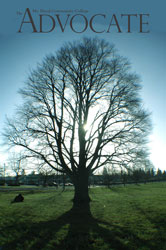History Grows at MHCC
Along the endless pathways that wind through an old-growth forest, some may never notice the diversity of trees and plants that make up the historical roots of the Mt. Hood Community College campus. Students hurry to classes through the affectionately nicknamed “Cherry Walk,” along the upper west side of the Academic Center, lined with weeping flowering cherry trees, bursting in pinks and whites every spring. A student studies under the large Cornus nuttallii, or Pacific flowering dogwood, behind a budding rhododendron, and breaths in the fragrances surrounding the Quercus palustris, or pin oak, behind the Student Center. Athletes in training may run right by the Magnolia quinquepeta (tulip trees) on the south side of the gym, without giving a thought to the age-old traditions of magnolia blossoms bringing good luck to other famous runners at Churchill Downs, home of the Kentucky Derby. Anyone hearty enough to hike through the tall forest to the back METRO green space will be treated to a plethora of birds and small animals, and on an occasion or two, a cougar has crossed the paths. In the late 60s to early 70s, MHCC campus was a barren field of dirt, without a single bush or tree, except for the stretch of old growth along the “back 40.” A little known fact is that every tree and bush on campus was planted in the architectural landscaping, amounting to over 3,500 plantings and hundreds of differing species. Some of the rarest trees are the tall Spanish firs that line the courtyard in front of the bookstore in cement planters, as well as behind the main mall. Because of the diversity, MHCC was designated a Significant Historical Arboretum several years ago. Spruces, pines, dwarf conifers, giant sequoias, and many other native and non-native plantings are among the horticultural makeup of landscaping blending into the 60 acres of greenbelt recently purchased by METRO. At the northeastern corner of the green space, a huge purple beech tree was planted by MHCC in memory of Oregon pioneer Alfred Baker, a stagecoach driver and the original farm owner of the MHCC campus, who died in 1907. The beech tree (seen on the cover) has been the place of many picnics and rare bird sightings and has become an historical landmark in the area. Kelly Creek, also known as Burlingame Tributary, runs through the center of campus, connecting to Beaver Creek along the center of the forest, according to Don Wallace, director of facilities management for MHCC. “A federal grant to develop and preserve the greenbelt was part of a good collaborative effort between four governments, when they all worked together to achieve this for the local community,” said Wallace, referring to Gresham, Troutdale, METRO, and the MHCCD Board. The plan is to maintain and improve the natural surroundings, keeping it accessible for the natural resources program and other classes that will benefit by its richness. The beauty and landscaping don’t come without work. Phil Parsley, lead groundskeeper for MHCC for 15 years, has his hands full when it comes to the maintenance. “Some of the non-native species are unable to withstand the southern winds and ice storms, so we have lost over a hundred in the last few winters,” said Parsley. “The cleanup of so many deciduous trees is overwhelming sometimes, and safety has become one of our biggest issues,” said Parsley. Other little known facts are the murder and rapes that occurred years ago in the densely forested areas. “The line of sight is badly hampered to our security officers by the landscaping,” said Wallace, “adding to the concern for safety.” “The Gresham and Troutdale police departments have both come and given advice to our security situations, and the common factor mentioned is the thick landscaping surrounding the parking areas,” said Wallace. “Unfortunately, we come up against groups that do not want any trees removed, not realizing that they were put there as part of an ever-changing landscape design, and didn’t grow there naturally,” added Wallace. “Even noble motives are mistaken sometimes,” he said. “Thinning some trees and adding lighting can really help the safety and richness of our rare and beautiful college campus, but the budget doesn’t allow for that kind of expansive work.” “The trees are beautiful, but low maintenance and sustainability would be a wiser choice. Trust me, it’s a jungle out there,” laughed Parsley.
|
